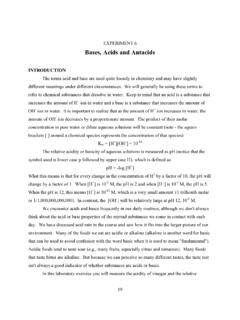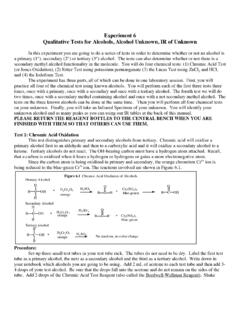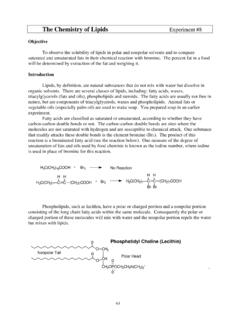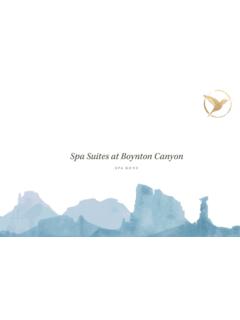Transcription of Experiment 17 Preparation of Methyl Orange
1 Experiment 17 Preparation of Methyl OrangeIn this Experiment you will prepare Methyl Orange , an azo dye that forms beautifulorange crystals and is used as an acid-base indicator (Figure ). The anion form isyellow and the acid form is Structure of Methyl OrangeSNNNCH3CH3 OOX + -Oyellow, pH > +SNNNCH3CH3 OOHOH Methyl orangered, pH < (inner salt form)You will synthesize Methyl Orange from sulfanilic acid and N,N-dimethylanilineusing a diazonium coupling reaction just like the one you saw in the previous experimentin the nitrous acid test for primary aromatic amines. The overall reaction is shown inFigure and the mechanism is shown in figure All of this chemistry is in yourtext in the chapter on amines. You need to understand Preparation of Methyl Orangesulfanilic acid1. Na2CO32. NaNO2 3. HClmethyl orangeThe first step is simply an acid base reaction. In order to dissolve the sulfanilicacid in the aqueous solution we add sodium carbonate.
2 Then we form the diazonium saltby the same mechanism that was presented in Figure of the previous we add the HCl, the nitroso ion is formed from sodium nitrite and this reacts withthe amine to form a nitrosoammonium adduct that loses water under the acidic conditionsafter proton transfer. This gives the diazonium salt. Aromatic diazonium salts are stableat low temperature. The terminal nitrogen of the diazonium salt is very electrondeficient. It can be attacked by good nucleophiles. We dissolve the dimethylaniline inacetic acid. This forms the dimethylaniline acetate salt. Neutralize this in situ and thedimethylaniline becomes a good nucleophile due to the activating effect of thedimethylamine substituent. Attack is in the para position due to hindrance at the orthoposition by the bulky dimethylamine + -OCOO- Na+H2 ONOH-ClSNH2 OOOHSNH2 OONa+ -OSNOOHOHHNOHClHClONOHHONOHNa+ -ONONOH2OH-ClSNOOHOHNOHCl-SNOOHONSNOOHON OHHH-ClH2 OHO--OCOCH3 NCH3H3 CNCH3 HCH3H2 OSNNNCH3CH3 OOHOSNNNCH3CH3 OOHOHH++sulfanilic acidNitroso ion formationFigure Mechanism for Methyl Orange FormationDiazonium saltnitroso ionWe neutralize the protonated dimethylaniline to make it into a good ConstantsCompoundMol.
3 Wt (g/mol)Density(g/mL) ( C) ( C)Sulfanilic , carbonate(anhydrous) carbonate(monohydrate) - -Sodium orange306 Procedure:In order to avoid any excess of a reagent that could decompose or causedecomposition and produce tar to contaminate our dye, you need to weigh the quantitiesof solid reagent very carefully to the accuracy of g or this Experiment you will have to calculate for yourself some of the amounts ofneeded reagents. After you have calculated them, confirm your results with the instructorbefore mole of sulfanilic acid (anhydride) in about 50 ml of a solution ofsodium carbonate containing to moles of sodium carbonate in a 125 mlErlenmeyer flask. The solution is prepared by the stockroom and its strength is indicatedon the bottle, but you must calculate the exact amount needed. Warm the mixtureslightly to speed up dissolution. Test one drop of the solution to make sure it is not, add a small amount (1-2 mL) sodium carbonate solution and check the pH add moles sodium nitrite and cool to 25 C (room temperature).
4 Put 40 g of ice in a 400 mL beaker and add enough hydrochloric acid of a 6M or a12 M solution in order to provide a total of mol HCl in your the sulfanilate solution prepared above in a fine stream while stirringcontinuously. Keep this solution cold in the ice bath at all times. It now contains yourdiazonium salt, which will decompose if it becomes warm. It is only partially soluble inthe aqueous solution and will precipitate as a bluish-greenish a solution of N,N-dimethylaniline ( mol) in mol of acetic acidin a 25 ml Erlenmeyer add the dimethylaniline acetate solution slowly with constant stirring to thesuspension of the diazonium salt. A dull, reddish-purple mass should , VERY SLOWLY add about 30 mL of M sodium hydroxide solutionwith constant stirring. Add the NaOH a few mL at a time. The addition should take 10 -15 minutes. The actual coupling reaction does not occur until you add the NaOH.
5 Thereaction takes place best at about pH 7. Keep adding the NaOH until the solutionbecomes basic (blue to litmus.)If the sodium hydroxide is added too quickly, then free dimethylaniline willseparate out as an oily phase. This then leaves an equivalent amount of the diazoniumsalt unreacted. This excess salt decomposes to brown tar on warming to roomtemperature and contaminates the otherwise beautiful crystalline Orange the end of the coupling reaction a yellow- Orange or golden color should beobserved. The product will now be recrystallized from the reaction mixture. Heat thereaction mixture to boiling using your tripod and Bunsen burner. Everything shoulddissolve and the solution should be clear (though it will be highly colored). If all thematerial does not dissolve when the solution is heated to boiling, add more water asneeded. Then, allow it to cool slowly to room temperature to crystallize and then placethe flask in an ice bath to get it as cold as possible.
6 Remember: do not stir or shake thesolution when it is cooling. Allow the crystals to form in an undisturbed flask. They willbe much purer and larger if they form slowly in a motionless the crystals by suction filtration, rinse them with 10 15 ml cold water andallow them to dry. Calculate the percent yield and turn in your crystals in a vial alongwith your Organic Yield Report not attempt to take the melting point of your Methyl Orange as it decomposeson heating. In order to observe the beautiful color change that occurs with our orangeindicator dye, dissolve a small amount of the Methyl Orange in 2-3 mL of 95% ethanoland add 5% HCl a few drops at a time until you see the color change. Describe yourresults in your notebook.









